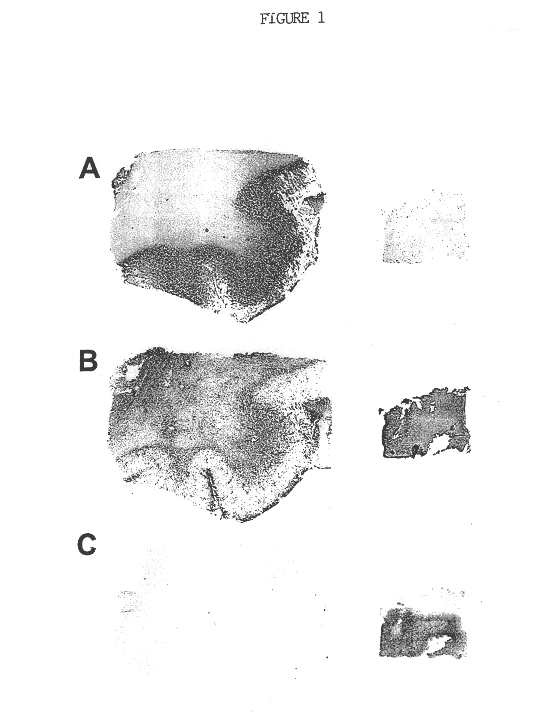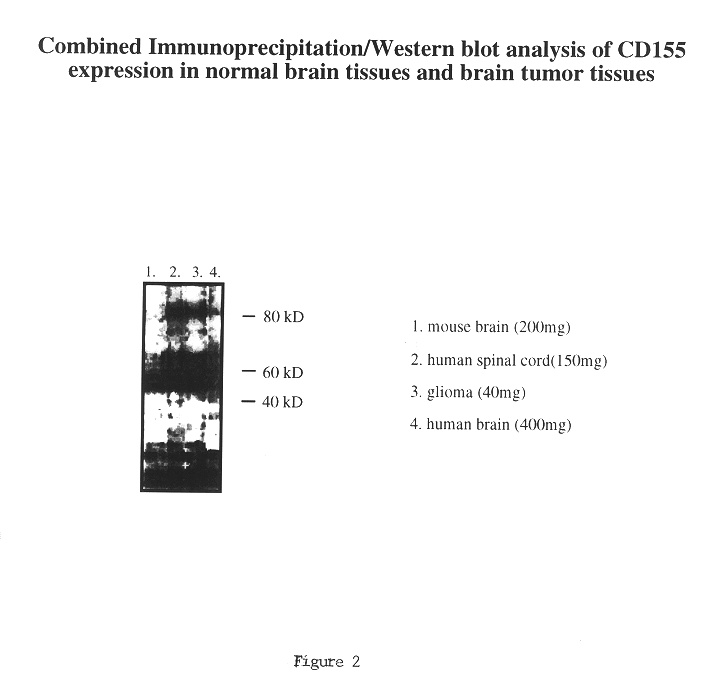Method of detecting the presence of CD155 for diagnosis of cancer and to determine treatment
a technology of cd155 and detection method, which is applied in the direction of viruses/bacteriophages, instruments, genetic material ingredients, etc., can solve the problems of difficult use in research and high cost of animals with a longer life cycl
- Summary
- Abstract
- Description
- Claims
- Application Information
AI Technical Summary
Problems solved by technology
Method used
Image
Examples
example 2
Immunohistochemistry of CD155 in Malignant Gliomas
Twenty seven specimens were collected from patients diagnosed with various malignant gliomas and assayed in accordance with the procedure described in Example 1 using as the first antibody, anti-GFAP or anti-CD155 for side by side comparison. Anti-GFAP antibody was used as the primary antibody in each control sample to show that the procedure was working properly. The results are presented in Table 1.
Based on the results obtained using antibodies to CD155 in the immunohistochemical procedure according to the present invention and the diagnosis obtained from pathological studies, the present method is appropriate not only for determining the presence of CD155 receptor on tissue and is also useful for determining the stage of tumor development and whether treatment with chimeric poliovirus was appropriate.
In Table 1, +++ corresponds to very strong-, ++ to strong-, + to moderate, and + / - to weak expression levels of CD 155. We observed ...
example 3
Immunohistochemical Detection of CD155 in Other Tumors
Sample of malignant tumors of the lung, breast, colon, bladder and salivary glands were obtained and tested in accordance with the procedure described in Example 1 using as the primary antibody, D171.
The results are presented in Table 2. The specific type of cancer for each of the tumor tissue is indicated.
example 4
Detection of CD155 in Tumor Tissue Homogenates by a Combined Immunoprecipitation / Western Blot Protocol
Brain tumor tissue and normal brain tissue was obtained from patients undergoing craniotomy for the removal of a malignant glioma. The tissue was immediately frozen in dry ice and stored a -70.degree. C. Tissue fragments were placed at room temperature, immersed in dissociation buffer (PBS containing 0.5% NP40, nonylphenoxy polyethoxy ethanol) and subsequently homogenized in a Dounce homogenizer.
The homogenate was centrifuged and the supernatant was removed.
Prior to this assay, protein A / sepharose that had been equilibrated in PBS was incubated over night with the mouse monoclonal anti-CD155 antibody D171. After three washes of the protein A / sepharose complex, 25 .mu.l of the mix was added to the homogenized tumor tissue supernatant. The solution containing the protein A / sepharose-D171 complex was incubated at 4.degree. C. over night. The sepharose beads were gently centrifuged and ...
PUM
| Property | Measurement | Unit |
|---|---|---|
| thickness | aaaaa | aaaaa |
| pH | aaaaa | aaaaa |
| thickness | aaaaa | aaaaa |
Abstract
Description
Claims
Application Information
 Login to View More
Login to View More - R&D
- Intellectual Property
- Life Sciences
- Materials
- Tech Scout
- Unparalleled Data Quality
- Higher Quality Content
- 60% Fewer Hallucinations
Browse by: Latest US Patents, China's latest patents, Technical Efficacy Thesaurus, Application Domain, Technology Topic, Popular Technical Reports.
© 2025 PatSnap. All rights reserved.Legal|Privacy policy|Modern Slavery Act Transparency Statement|Sitemap|About US| Contact US: help@patsnap.com


